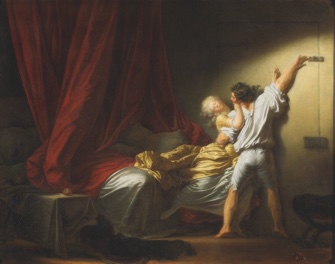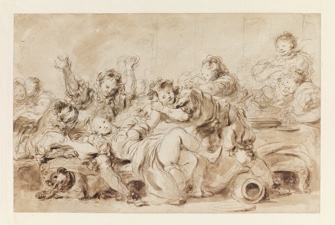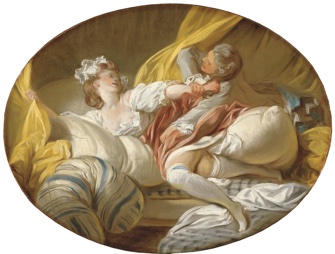
When his pictures weren’t downright naughty, they were often breathlessly passionate, but apparently Jean-Honoré Fragonard (1732-1806), the illustrator of the libertine era par excellence, didn’t practice what he painted. Falsely credited with passionate liaisons with famed courtesans, he was actually a steady, faithful husband and doting father. When he painted the often risqué and sometimes licentious works shown in the exhibition “Fragonard Amoureux, Galant et Libertine” at the Musée du Luxembourg, he was just giving the public of his time what it wanted (and perhaps taking vicarious pleasure in the eroticism of his pictures?).
Some of those pictures can be almost offensive to our modern mores. “Les Suites de l’Orgie” (1765-70), primly titled “Festive Meal” in English by its owner, the Museum Boijmans Van Beuningen in Rotterdam (I would

translate it as “Aftermath of the Orgy”) shows a mass of entangled bodies with raised skirts of what appear to be children. Titles of other works like “La Résistance Inutile” (“Useless

Resistance”) seem to imply that a rape is in progress. In “Le Verrou” (pictured at the top of this page), a young man reaches up with his right arm to lock the door while the distressed-looking young woman he has firmly gripped in his left arm tries ineffectually to stop him and push him away (French art historian Daniel Arasse saw symbols of both male and female genitals in the jumbled mass of bedclothes and draperies that take up over half the painting).
Voyeurs were well served by such works as a series of drawings of girls sporting in a dormitory in various states of undress, or “Deux Femmes sur un Lit Jouant avec Deux Chiens ou Le Lever” (“Two Women on a Bed Playing with Two Dogs,” c. 1770), in which one woman lies on her stomach with her generous buttocks uncovered while the other stands on the bed, raising her skirt up above her waist and exposing her genitals.
As highly suggestive as many of Fragonard’s paintings and drawings were, however, sometimes verging on soft porn, they were never really explicit, unlike works by some of his contemporaries included in the show. In “Etreinte” (c. 1730), attributed to Jean-Baptiste Pater, for example, the couple depicted are clearly having sex, whereas in Fragonard’s works, even those with the most nudity, the lovers are caught in that moment of intense

heat just before the act, as in “L’Instant Désiré” (c. 1770).
The exhibition, with some 80 works, makes the point that even though he was not really a libertine, he was in every other way a man of his time, influenced by fellow artists, including François Boucher, Pierre-Antoine Baudouin and Jean-Baptiste Greuze, and writers like Denis Diderot and Jean-Jacques Rousseau.
While Fragonard’s frothy style does not appeal to my own sensibilities, his works have their charms and serve as a sort of relic of a time and place and lifestyle that were soon to disappear as Louis XV’s libertine reign gave way to the less-licentious era of Louis XVI and then the upheaval of the Revolution.
Favorite
